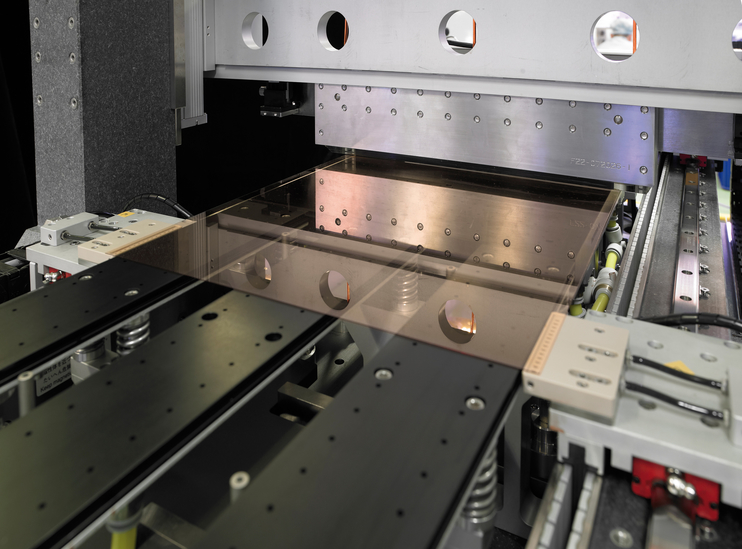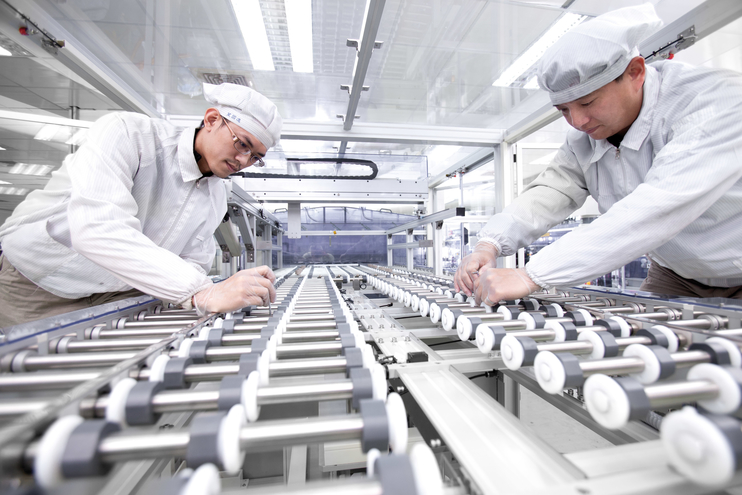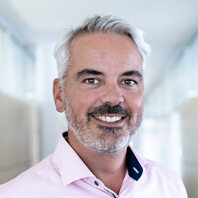
04/04/2012 15:37:00 CEST
Equipment for touch panel manufacturing at Manz in Asia.
Reutlingen, April 04, 2012. In the middle of February and at the end of March, Manz AG announced contracts with a total value of around 65 million euros for equipment to manufacture flat panel displays (FPD). The FPD segment was already the high-tech engineering firm’s most important area of business in 2011 – with approximately a 40-percent share of revenue, even ahead of the Solar division. In this interview, CEO and founder Dieter Manz explains why FPD also promises to have good growth prospects in 2012 as well, and why Manz’s long-term diversification strategy is now paying off.
1. The big picture: How do you assess the business environment for display manufacturers?
Demand for large-sized LCD televisions remains high, with the market in Asia growing particularly fast. China is now the largest single market for LCD TVs. We are also seeing high demand for smaller displays for use on smartphones, tablet computers, and GPS navigation devices. With the iPhone® and the iPad®, Apple created a huge new market segment within only a few years. Other manufacturers now also offer similar devices, which will lead to further growth. But that is also a reason why competition in this market is extremely fierce, which has led to display manufacturers’ margins being extremely thin or even negative. Manufacturers will only be able to counteract this competitive pressure with production systems that are increasingly efficient – on the one hand, they need to be designed for larger substrate sizes; and on the other hand, throughput times need to be continuously reduced. Furthermore, the display industry is also seeing new factories no longer being constructed in Taiwan or South Korea, but in China.
2. Technologies: What exactly do display manufacturers need systems from Manz?
On the one hand, to automate the production process. On the other, we are the specialist for all of their wet chemical processes. These encompass the production steps such as cleaning the substrates and, in particular, developing photoresists and etching the fine structures on LCDs, touch sensors, and OLED panels (organic light-emitting diode). All of these products are manufactured in a clean room. That is why all Manz systems are certified for clean rooms by the Fraunhofer IPA Institute in Stuttgart. This requirement and the substrate sizes used in LCD production of up to six square meters with a maximum substrate thickness of 0.7 millimeters make manual handling impossible. Our fully automated systems, such as those for loading and unloading in-line sputter systems, laser-cutting glass substrates, and conducting in-line inspections, all operate with minimal breakage rates and maximum throughput speed. As a result, we have a unique selling point in the field of FPD.
3. Diversification: Manz developed the first automation solution for manufacturing crystalline solar cells in 1990. Since when have you been focusing on FPD manufacturing?
We have been building automation systems for handling glass substrates of all sizes for almost 20 years. Our first systems were shipped to customers in Japan then later South Korea and Taiwan. Today a significant share of our systems is installed in China. We expanded this expertise in 2008 with the acquisition of the Taiwanese company Intech – the market leader for wet chemical processing equipment for FPD in Taiwan and China. In addition, this step made it easier for us to enter the Asian market. Since then we have had production capacity in Taiwan and in the People’s Republic of China. We are currently constructing a new factory with 16,000 square meters of production space (in the first stage of expansion) at the Manz Asia Ltd. location in Suzhou. There we can manufacture for both the photovoltaic market and FPD industry and offer our customers German quality on local terms.
4. Customer value: How do customers benefit from Manz’s diversification?
In Taiwan, we successfully integrated technologies that we developed for the manufacture of crystalline solar cells or thin-film solar modules into products for the FPD industry, such as our coating system – the Manz Slit Coater. And conversely, we have also successfully adapted wet chemical systems, such as those to clean glass substrates, for customers in the solar industry. These synergies have led to us covering an increasing number of processing steps along both value chains. As a result, we can increase a production line’s level of integration, which significantly cuts production costs. And our latest FPD contracts for systems valued at 65 million euros are substantially based on technology for the solar industry.
5. Outlook: What role will the flat panel display segment play in 2012?
In Asia, we are also seeing an increasing trend toward automating production processes as a result of increasing personnel costs and the often-required improvements to working conditions and product quality. In addition, the market for mobile devices will continue to grow extremely dynamically. That is why we are going to continue expanding our production capacities. As a result, we are extremely confident that our FPD division will see excellent growth in 2012 as well. This is particularly important to us, since we are only expecting the photovoltaic market to recover very slowly in 2012. Thanks to the technological synergies between the FPD and solar industry, we can compensate for a lack of revenue in the latter.

Manz@work in display manufacturing: The Manz G2 Slit Coater for photoresist coating in the touch panel litho production.

Manz G2 Slit coater eliminates substrate damages as caused by conventional transmission approaches.
